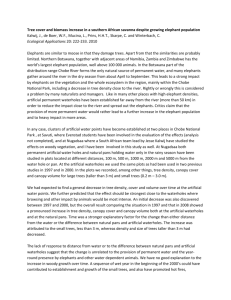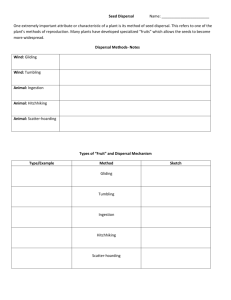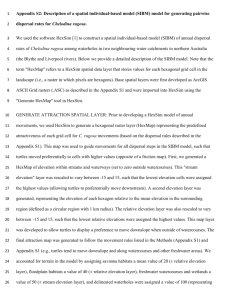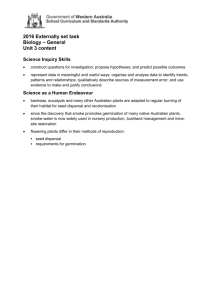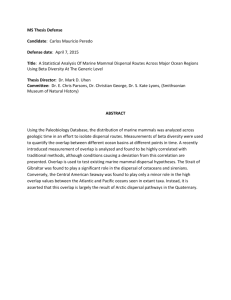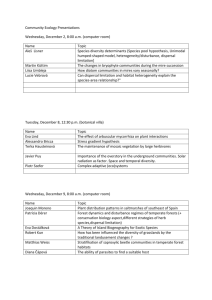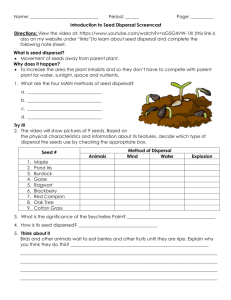Appendix S1: Online Extended Methods
advertisement
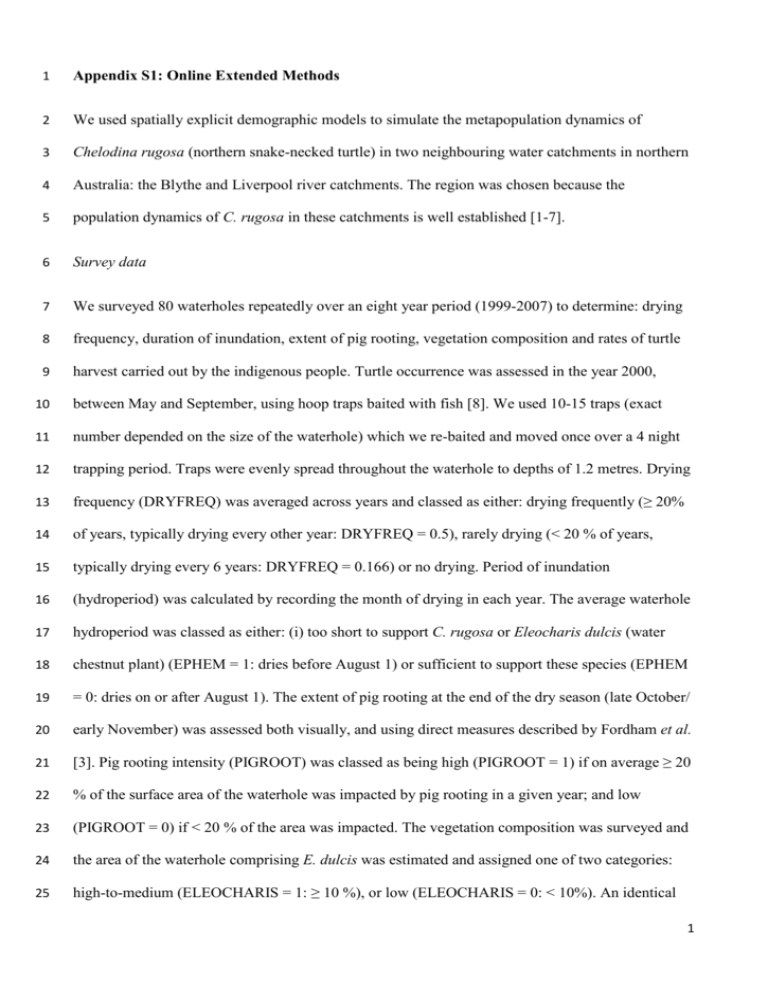
1 Appendix S1: Online Extended Methods 2 We used spatially explicit demographic models to simulate the metapopulation dynamics of 3 Chelodina rugosa (northern snake-necked turtle) in two neighbouring water catchments in northern 4 Australia: the Blythe and Liverpool river catchments. The region was chosen because the 5 population dynamics of C. rugosa in these catchments is well established [1-7]. 6 Survey data 7 We surveyed 80 waterholes repeatedly over an eight year period (1999-2007) to determine: drying 8 frequency, duration of inundation, extent of pig rooting, vegetation composition and rates of turtle 9 harvest carried out by the indigenous people. Turtle occurrence was assessed in the year 2000, 10 between May and September, using hoop traps baited with fish [8]. We used 10-15 traps (exact 11 number depended on the size of the waterhole) which we re-baited and moved once over a 4 night 12 trapping period. Traps were evenly spread throughout the waterhole to depths of 1.2 metres. Drying 13 frequency (DRYFREQ) was averaged across years and classed as either: drying frequently (≥ 20% 14 of years, typically drying every other year: DRYFREQ = 0.5), rarely drying (< 20 % of years, 15 typically drying every 6 years: DRYFREQ = 0.166) or no drying. Period of inundation 16 (hydroperiod) was calculated by recording the month of drying in each year. The average waterhole 17 hydroperiod was classed as either: (i) too short to support C. rugosa or Eleocharis dulcis (water 18 chestnut plant) (EPHEM = 1: dries before August 1) or sufficient to support these species (EPHEM 19 = 0: dries on or after August 1). The extent of pig rooting at the end of the dry season (late October/ 20 early November) was assessed both visually, and using direct measures described by Fordham et al. 21 [3]. Pig rooting intensity (PIGROOT) was classed as being high (PIGROOT = 1) if on average ≥ 20 22 % of the surface area of the waterhole was impacted by pig rooting in a given year; and low 23 (PIGROOT = 0) if < 20 % of the area was impacted. The vegetation composition was surveyed and 24 the area of the waterhole comprising E. dulcis was estimated and assigned one of two categories: 25 high-to-medium (ELEOCHARIS = 1: ≥ 10 %), or low (ELEOCHARIS = 0: < 10%). An identical 1 26 area-based assessment was made for Melaleuca sp. Harvest frequency (HARVFREQ) was assessed 27 using direct observations and surveys (see [7]). 28 Environmental spatial data 29 Wetland features were mapped using high resolution scans of 1:50,000 topographic maps produced 30 by the Army Topographic Support Establishment (Department of Defence, Commonwealth of 31 Australia) in 1999. Specifically, twenty four maps covering the Blyth and Liverpool catchments 32 downstream of the Arnhem Land sandstone escarpment were scanned, geo-referenced and wetland 33 features were digitised using ArcGIS 10. This produced a polygon map of waterhole features and 34 their associated attributes: (i) VEG: vegetation density (1 = dense, 0 = sparse or absent); (ii) AREA: 35 wetland area (ha); (iii) PERVEG: percent area of the waterhole that is vegetated; (iv) 36 PERMANENT: whether the waterhole is inundated even during unusually dry years (1 = 37 permanent, or 0 = ephemeral); and (v) SALTWATER: salinity content (1 = salt water, or 0 = fresh 38 water). Wetland features were digitised at a 1:5,000 – 1:7,500 scale. A horizontal accuracy of 90% 39 within ± 25m exists for features on the original topographic maps. We did not include the sandstone 40 catchment area because Chelodina burrungandjii, not C. rugosa, is found in this region [9]. 41 Digital spatial layers describing major road networks, water courses and towns and 42 outstations (satellite communities) were accessed from GeoScience Australia (GEODATA TOPO 43 250K Series 3 - Online [via MapConnect]; ANZCW0703008969). The layers were used to calculate 44 distances from each wetland feature to the nearest road (DISTROAD), river (DISTRIVER), and 45 outstation (or town; DISTTOWN) using the Near function in Spatial Analyst ArcGIS v10. The 46 National Vegetation Information System broadly describes the present-day vegetation of the 47 Northern Territory of Australia [10] and was used to distinguish floodplain (SAVANNA = 0) and 48 savannah (SAVANNA = 1) vegetation communities. 49 Elevation was based on a 30m Digital Terrain Model derived from the NASA SRTM project 50 [11]. From this, slope was calculated using the ‘DEM Surface Tools’ ArcGIS extension [12]. A map 2 51 of plant available water capacity (PAWC, a measure of soil water available to plants at 250 x 250m 52 grid-cell resolution) was accessed from the Australian Soil Resource Information System 53 (http://www.asris.csiro.au). National soil data was provided by the Australian Collaborative Land 54 Evaluation Program ACLEP (www.clw.csiro.au/aclep). All spatial layers are available from the 55 authors on request. 56 Predictions of abundance and carrying capacity 57 Three features of waterholes were previously identified as key determinants of occurrence, 58 abundance and vital rates for C. rugosa: the density of E. dulcis at a waterhole, the drying 59 frequency, and the period of inundation [2, 3]. We used binary logistic regression to model the 60 relationship between mapped environmental variables and: (i) ELEOCHARIS: presence of E. dulcis 61 (observed density ≥ 10 % or < 10 %); and (ii) EPHEM: whether waterholes dry or not before 62 August (a hydroperiod too short to support populations of C. rugosa). We used ordinary linear 63 regression to model the relationship between mapped environmental variables and drying frequency 64 (DRYFREQ; described above) (we compared logit-transformed and untransformed DRYFREQ 65 models and found that modelling untransformed DRYFREQ as the response variable resulted in a 66 slightly lower cross-validation error). Models were built using survey information from 50 67 ephemeral waterholes within the study region. We hypothesised a priori that these waterhole 68 features are affected by elevation, slope, waterhole area (AREA), PAWC, being in a floodplain or 69 savanna environment (SAVANNA), and vegetation density (VEG; see above for a description of 70 spatial features). The final predictor set was selected by first eliminating highly correlated variables 71 from the predictor set (one variable was retained for each pair with Pearson correlation > 0.75) and 72 subsequently selecting the best-performing combination of predictor variables using stepwise AICc 73 (Akaike Information Criterion, with a correction for limited sample size [13]). We calculated 74 proportion of deviance explained (hereafter R2 [14]) as a summary statistic to describe structural 75 goodness-of-fit [15]. 3 76 We assessed the predictive performance of the selected models using leave-one-out cross 77 validation and subsequently computing area under the receiver operating curve (AUC) [16]. The 78 best models for ephemerality (logit(EPHEM)= -0.17 - 9.4E-6*[AREA] + 0.18*[SAVANNA] – 79 18.7*[VEG], R2 = 0.35) and drying frequency (DRYFREQ = 0.4 + 0.0028*PERVEG – 80 0.23*[SAVANNA]; R2 = 0.53) exhibited adequate model performance (AUC > 0.8) [17]. However, 81 cross validation for E. dulcis presence (i.e., ELEOCHARIS ≥ 10%) suggested poor predictive 82 performance (AUC < 0.7). Therefore, we developed a simple set of rules based on field 83 observations to predict E. dulcis presence in the Blythe and Liverpool catchments. We classified a 84 waterhole as having E. dulcis if it dries regularly (> 20 % of years; DRYFREQ = 0.5) , but not 85 before August [3] (EPHEM = 0); and if it is not a marine swamp, or if it is not a sparsely vegetated 86 waterhole (VEG = 0) in a savanna habitat (SAVANNA = 1). 87 We used the spatial predictions of waterhole features (generated as described above) and 88 area of the waterhole (number of 50m x 50m pixels) to predict the initial abundance and carrying 89 capacity for each of the 1,013 waterholes in the study region. The surveyed waterholes captured the 90 environmental features of the study region, meaning that modelled predictions of waterhole features 91 did not extrapolate to novel environmental conditions. We used published [5] and unpublished 92 capture-mark-recapture (CMR) estimates of abundance at waterholes differing in drying frequency 93 and timing, density of E. dulcis and pig predation rates to calculate average abundance at 94 waterholes. We set abundance as follows: (i) rarely drying waterholes (dries ≤ 20 % of years) with 95 no E. dulcis = 5.5/ha; (ii) frequently drying waterholes (dries > 20 % of years) with E. dulcis = 96 9.5/ha; (iii) frequently drying waterholes with no E. dulcis = 5.5/ha; (iv) waterholes that dry 97 annually before August = 0/ha; and (v) permanent waterholes = 3/ha. Predicted abundance was 98 verified using an independent set of 10 waterholes with CMR estimates of average abundance. With 99 the exception of one site, all model estimates agreed with CMR estimates of abundance (i.e., fell 100 within the confidence bounds surrounding abundance). A subset of waterholes, with predicted turtle 101 abundance = 0, were verified using occurrence survey data. 4 102 The size distribution of C. rugosa is strongly influenced by drying frequency and pig 103 predation [3]. Populations in waterholes that dry infrequently experience low levels of recruitment 104 because densities are close to carrying capacity (K) [5]. Populations in waterholes that dry 105 frequently with E. dulcis tend to experience the highest levels of predation from pigs or harvested 106 by humans, resulting in elevated recruitment and populations being maintained below K [3]. We 107 used these observations to estimate K for each waterhole: (i) rarely drying waterholes with no E. 108 dulcis = 5.5/ha (i.e., K = initial abundance); (ii) frequently drying waterholes with E. dulcis = 109 14.25/ha (i.e., K = 1.5 * initial abundance); (iii) frequently drying waterholes with no E. dulcis = 110 6.6/ha (i.e., K = 1.2 * initial abundance); and (iv) permanent waterholes = 3/ha. Waterholes with K 111 < 10 animals were treated as non-viable populations (i.e., K was set to zero) in the demographic 112 model. 113 Human mediated effects: pig predation and harvest rates 114 We hypothesized that harvest frequency (measured at 32 waterholes) and pig visitation rates 115 (measured at 50 waterholes) were strongly influenced by the distance to the nearest outstation. We 116 fitted models using maximum likelihood, assuming a Gaussian error distribution for logit- 117 transformed harvest rates and a binomial error distribution for pig predation impact (measured as 118 high or low). Model selection was performed using AICc. Heavy pig visitation only occurred in 119 wetlands with high E. dulcis abundance (E. dulcis, not C. rugosa, is the primary target for pigs [2]), 120 thus the relationship between pig visitation and outstation distance was modeled only for those 121 surveyed sites with a high abundance of E. dulcis (n = 22). 122 Harvest frequency decreased with distance from the nearest outstation, and was modelled using four 123 plausible functional forms: linear, exponential decay, logit-linear, and logit-exponential. We found 124 the logit-exponential function to best describe the relationship between harvest and distance 125 (logit(HARVFREQ) = 10.6*exp(-[DISTTOWN]/5.57) – 4.43). Feral pig impact (PIGROOT) 126 increased with distance from the nearest outstation, and was modelled using two plausible 5 127 functional relationships: logit-linear or a "broken stick" logit-linear model (in which the relationship 128 assumes different logit-linear slopes on either side of a threshold value). The modelled relationship 129 between distance from village and probability of pig rooting and harvest was best described by the 130 broken stick model (< 1.07 km: PIGROOT = 0, ≥ 1.07 km: logit(PIGROOT) = -0.38 + 131 9.28*[DISTTOWN]). 132 133 Fig. A1-1. Probability of extensive pig visitation (red) and probability of human exploitation (blue) 134 at occupied waterholes as a function of the distance to the nearest outstation. Note that pig 135 visitation is only displayed for waterholes with high abundance of E. dulcis. 136 Demographic model 137 We constructed spatially explicit stage- and sex-based stochastic matrix models for C. rugosa in 138 RAMAS GIS v5 [18]. The model consisted of 4 female stages and 2 male stages: (i) Female S1 = < 139 140mm; (ii) Female S2 = 140-180mm; (iii) Female S3 = > 180-220mm; (iv) Female S4 = > 220mm; 140 (v) Male S5 < 140mm; (vi) Male S6 > 140mm [4]. Previously, Fordham et al. [4] constructed three 6 141 baseline C. rugosa stage matrices describing vital rates as a function of drying, the density of E. 142 dulcis and the level of pig predation. Each waterhole (with C. rugosa abundance > 0) was assigned 143 one of these baseline stage matrices: (i) rarely drying waterholes = matrix 1; (ii) frequently drying 144 waterholes with E. dulcis = matrix 2; (iii) frequently drying waterholes with no E. dulcis = matrix 1; 145 and (iv) permanent waterholes = matrix 3 (online Appendix S3). Frequently drying waterholes with 146 E. dulcis and high pig rooting occurring in < 50 % years (because they are closely located to human 147 settlements) were assigned matrix 1. 148 In years of high rainfall, frequently drying waterholes do not dry [3]. This was simulated 149 using the catastrophe function of RAMAS, whereby drying frequency was used to determine the 150 probability of a wet year (based on Fordham et al. [4]) and a local multiplier was used to account 151 for the positive effect not drying in a given year can have on abundance. Harvesting of C. rugosa 152 for indigenous consumption occurs in dry years at waterholes with E. dulcis that are close to 153 outstations (< 15 km away) and where pig abundance is low. We simulated harvesting using a 154 second catastrophe function, whereby the local probability of a harvest event was defined by the 155 probability of waterhole drying multiplied by the probability that the waterhole will be harvested 156 (i.e., based on distance from the nearest outstation). In savanna environments, we constrained the 157 probability of harvest to waterholes with E. dulcis, where pig abundance is predicted to be low. In 158 these waterholes harvest caused a 20% decline in stage classes > 140 mm [4]. In floodplain 159 environments, the indigenous people will catch turtles even in the presence of high densities of pigs, 160 but the harvest rates are much lower (Fordham unpublished data). We simulated harvesting in 161 floodplain environments up to 15 km from outstation settlements causing 10% decline in stage 162 classes > 140 mm. 163 We modelled environmental variation affecting C. rugosa survival using CMR data [3] 164 analysed in Program Mark with sampling variation removed [19]. We set the CV for survival in 165 years when waterholes: (i) do not dry to 0.06 (SD = 0.057); (ii) dry with low levels of pig rooting (≤ 7 166 20%) to 0.04 (SD = 0.031); and (iii) dry with high levels of pig rooting (> 20%) to 0.15 (SD = 167 0.089). Underwater nesting, multiple clutching and embryonic diapause buffers C. rugosa fecundity 168 against environmental variation [1]. We modelled hatchling survival as density dependent. Density 169 manipulation experiments (removal and supplementation) have shown that C. rugosa hatchling 170 survival is strongly influenced by the density of turtles ≥ 140 mm [5]. Previously we modelled this 171 relationship using a density decay function [4]. Here we use a similar approach through a function 172 that multiplies maximum fecundities by the survival of hatchlings calculated as: 173 Φ0 = 0.9385 * exp(-3.88 * (N/K) ) 174 Where N = population size, and K is the carrying capacity of animals > 140 mm. 175 Dispersal models 176 Dispersal was modelled as the proportion of individuals ≥ 140 mm [7] dispersing between each pair 177 of defined populations during the wet season (since dispersal does not occur at other times of the 178 year [2]). We used CMR field data, combined with expert knowledge, to model C. rugosa dispersal. 179 Specifically, for any pair of populations, dispersal frequency was computed as the fraction of the 180 total marked population at the source population that was recaptured at the target population. These 181 observed dispersal rates were used to calibrate three different models for estimating dispersal rates 182 between pairs of waterholes. 183 1. Dispersal kernel – null model: Dispersal was modeled as a function of centre-to-edge distance 184 using a simple distance-based dispersal kernel, extrapolated from field-based estimates of average 185 and maximum C. rugosa movement. Centre-to-edge was selected over the edge-to-edge method to 186 soften the "drainage effect" by which very large populations are drained into smaller satellite 187 populations nearby [20]. We used the dispersal-distance function, 188 a * exp(−Dijc/b) = 0.2 exp(−Dij2.4/1.8) Equation S1-1 (Equation S1-2) 8 189 where D is distance from the centre of the source population to the closest edge of the target 190 population, with a maximum recorded dispersal distance of Dmax = 4 km (above which dispersal rate 191 = 0). The intercept (a = 0.2) approximates the highest rate of immigration recorded from a single 192 population. The constant b was set to 1.8 and represents mean distance between a subset of 193 connected populations used to estimate dispersal (i.e., based on field observations). The constant c 194 was set iteratively so that < 5 % (2.8 %) of the population moves 1.8km in a single year based on CMR 195 data, in accord with dispersal rates observed in the field. 196 2. Friction-based – structural connectivity: Dispersal was modelled using a least-cost pathway 197 method that combined a friction map (cost-of-movement raster) with the dispersal kernel described 198 above [18], allowing dispersal to be modelled as a function of structural connectivity. We used 199 raster algebra ("raster" package for R) to generate a GIS cost-of-movement ("friction") raster for 200 the study region. Specifically, we used CMR data, observations from radiotelemetry, and expert 201 knowledge to develop the following rules to represent cost-of-movement through a 50 m grid cell: 202 (i) savanna habitat = 1; (ii) floodplain habitat = 0.5 (i.e., cost of moving across two floodplain cells 203 = cost of moving across one savanna cell); (iii) freshwater wetland and stream habitat = 0.33; (iv) 204 waterhole habitat = 0.25; and (v) salt water and dense forest habitat = 100 (i.e., cost of moving 205 across 0.01 % of a salt water or dense forest cell = cost of moving across one savanna cell). In the 206 dispersal kernel (Eq. S1-2), D now represents the cost-distance (cumulative cost of movement along 207 the least-cost path) from the centre of the source population to the closest edge of the target 208 population. In RAMAS GIS, the value 1 represents the baseline value of the cost-of-movement 209 raster: if all grid cells in the cost-of-movement raster were set to 1, estimated dispersal rates would 210 match the distance-based estimates derived from Eq. S1-2 [18]. Since savanna grid cell values were 211 set to 1, and most surveyed waterholes were located in savanna environments in the cost-of- 212 movement raster, the remaining parameters of the dispersal kernel (Eq. S1-2) were not altered for 213 this analysis.. 9 214 3. Individual-based model – functional connectivity: We modelled the interaction between turtle 215 movement and habitat using a spatially explicit individual-based model (SIBM) parameterised in 216 HexSim, which is a flexible software framework for individual-based ecological modeling and risk 217 assessment [21]. Our mechanistic SIBM dispersal model was designed to assess dispersal rates for a 218 single wet season (the period during which long-distance movements occur for C. rugosa [2]). All 219 waterholes were initialized at carrying capacity (as described above). All turtle movements in the 220 SIBM model were guided by an "attraction" surface (a map composed of hexagonal grid cells) that 221 formalized four movement rules, described below. These movement rules were developed 222 according to field observations of C. rugosa, and in recognition of the general dependence of this 223 species on freshwater habitats for foraging and dispersal. 224 Rule 1: Dispersal movements occur during the wet season, during periods when streams are 225 flowing and much of the floodplain is inundated [2]. We therefore assigned "attraction" values 226 such that: (i) streams represented important movement conduits; (ii) turtle movement directions 227 were biased downstream( high flow rates in rivers and streams during the wet season tend to 228 carry individuals downstream [22]); and (iii) increased movement rates in floodplain 229 environments. 230 Rule 2: Turtles tend to exit waterholes on the downstream side of the waterhole and move in a 231 downslope direction when dispersing in savanna environments, presumably to locate wetlands. 232 Rule 3: Turtles are repelled by salt water, dense forests and the sandstone escarpment, which 233 serve as reflective boundaries. 234 Rule 4: Turtles are free to leave the water catchments [6] - so the edges of the study region were 235 modelled as absorbing boundaries. We did not consider immigration from outside the two water 236 catchments. 10 237 The SIBM model was developed to better capture such functional elements of connectivity by 238 including mechanisms that allowed the following biologically realistic properties to emerge: (i) 239 turtles occupying waterholes with greater edge to area ratio are more likely to leave their home 240 patch; (ii) turtles are more likely to successfully disperse if a site has more and larger neighbouring 241 waterholes, and disperse further if neighbouring waterholes are closely linked by streams and rivers; 242 and (iii) dispersing turtles are more likely to return to where they came from if neighbouring sites 243 are mostly small and distant (Chelodina sp. show strong homing behaviours to favourable habitat 244 [23]). A detailed description of the SIBM model is provided in Appendix S2. 245 Model Simulations 246 The influence of dispersal (captured using null, structural connectivity, and functional connectivity 247 models) on spatial abundance patterns and local range limits was simulated using 10,000 stochastic 248 replicates, run over a 101 year period (i.e., 2000 - 2100). Population viability was assessed using 249 expected minimum abundance (EMA), a continuous metric reflecting risks of both declines and 250 extinction risk [24], calculated for the period: 2010 –2100. Range movement between 2010 and 251 2100 was calculated annually based on the latitude of the geographic centre of the most southern 252 sub-population [25]. Change in the number of occupied waterholes and total population abundance 253 (of persistent model runs) over time were also investigated. 254 References 255 [1] Fordham, D., Georges, A. & Corey, B. 2006 Compensation for inundation-induced embryonic 256 diapause in a freshwater turtle: Achieving predictability in the face of environmental 257 stochasticity. Funct. Ecol. 20, 670-677. 258 [2] Fordham, D., Georges, A., Corey, B. & Brook, B.W. 2006 Feral pig predation threatens the 259 indigenous harvest and local persistence of snake-necked turtles in northern Australia. Biol. 260 Conserv. 133, 379-388. 11 261 [3] Fordham, D.A., Georges, A. & Brook, B.W. 2007 Demographic response of snake-necked 262 turtles correlates with indigenous harvest and feral pig predation in tropical northern Australia. J. 263 Anim. Ecol. 76, 1231-1243. 264 [4] Fordham, D.A., Georges, A. & Brook, B.W. 2008 Indigenous harvest, exotic pig predation and 265 local persistence of a long-lived vertebrate: managing a tropical freshwater turtle for 266 sustainability and conservation. Journal of Applied Ecology 45, 52-62. 267 268 269 [5] Fordham, D.A., Georges, A. & Brook, B.W. 2009 Experimental evidence for density-dependent responses to mortality of snake-necked turtles. Oecologia 159, 271-281. [6] Alacs, E. 2008 Forensics, phylogeography and population genetics: a case study using the 270 Australasian snake-necked turtle, Chelodina rugosa. PhD Thesis. Canberra, University of 271 Canberra. 272 [7] Fordham, D. 2007 Population regulation in snake-necked turtles in northern tropical Australia: 273 modelling turtle population dynamics in support of Aboriginal harvests. PhD Thesis. Canberra, 274 University of Canberra. 275 276 [8] Kennett, R. 1992 A new trap design for catching freshwater turtles. Wildlife Research 19, 443445. 277 [9] Thomson, S., Kennett, R. & Georges, A. 2000 A new species of long-necked turtle (Testudines: 278 Chelidae) from the Arnhem Land plateau, Northern Territory, Australia. Chelonian Conservation 279 and Biology 3, 675-685. 280 281 282 283 284 285 [10] ESCAVI. 2003 Australian Vegetation Attribute Manual: National Vegetation Information System Version 6.0. Canberra, Department of the Environment and Heritage. [11] Jarvis, A., Reuter, H.I., Nelson, A. & Guevara, E. 2008 Hole-filled SRTM for the globe Version 4. Available from the CGIAR-CSI SRTM 90m Database (http://srtm.csi.cgiar.org). [12] Jenness, J. 2013 DEM Surface Tools. Jenness Enterprises. Available at: http://www.jennessent.com/arcgis/surface_area.htm. 12 286 287 288 289 [13] Burnham, K.P. & Anderson, D.R. 2002 Model Selection and Multimodel Inference, 2nd edn. New York, Springer. [14] McFadden, D. 1974 Conditional logit analysis of qualitative choice behavior. In Frontiers in Econometrics (ed. P. Zarembka), pp. 105-142, Academic Press. 290 [15] Nakagawa, S. & Schielzeth, H. 2013 A general and simple method for obtaining R2 from 291 generalized linear mixed-effects models. Methods in Ecology and Evolution 4, 133-142. 292 (doi:10.1111/j.2041-210x.2012.00261.x). 293 294 [16] Guisan, A. & Thuiller, W. 2005 Predicting species distribution: offering more than simple habitat models. Ecology Letters 8, 993-1009. 295 [17] Swets, J. 1988 Measuring the accuracy of diagnostic systems. Science 240, 1285-1293. 296 [18] Akcakaya, H.R. & Root, W.T. 2005 RAMAS GIS: linking landscape data with population 297 298 viability analysis (version 5.0). Setaukey, N.Y., Applied Biomathematics. [19] White, G.C., Burnham, K.P. & Anderson, D.R. 2001 Advanced features of Program Mark. In 299 Wildlife, land, and people: priorities for the 21st century. Proceedings of the Second 300 International Wildlife Management Congress. (eds. R. Field, R.J. Warren, H. Okarma & P.R. 301 Sievert), pp. 368–377. Bethesda, Maryland, USA, The Wildlife Society. 302 303 304 [20] Akçakaya, H.R. & Atwood, J.L. 1997 A habitat based metapopulation model of the California gnatcatcher. Conserv. Biol. 11, 422-434. [21] Schumaker, N.H. 2013 HexSim Version 2.5.7. Corvallis, Oregon, U.S. Environmental 305 Protection Agency, Environmental Research Laboratory. Available online at 306 http://www.hexsim.net. 307 [22] Rustomji, P. 2009 A statistical analysis of flood hydrology and bankfull discharge for the Daly 308 River catchment, Northern Territory, Australia. In Water for a Healthy Country Report. 309 Canberra, CSIRO. 310 311 [23] Roe, J.H. & Georges, A. 2007 Heterogeneous wetland complexes, buffer zones, and travel corridors: Landscape management for freshwater reptiles. Biol. Conserv. 135, 67-76. 13 312 313 314 [24] McCarthy, M. & Thompson, C. 2001 Expected minimum population size as a measure of threat. Anim. Conserv. 4, 351-355. [25] Watts, M.J., Fordham, D.A., Akçakaya, H.R., Aiello-Lammens, M.E. & Brook, B.W. 2013 315 Tracking shifting range margins using geographical centroids of metapopulations weighted by 316 population density. Ecol. Model. 269, 61-69. 317 318 14
